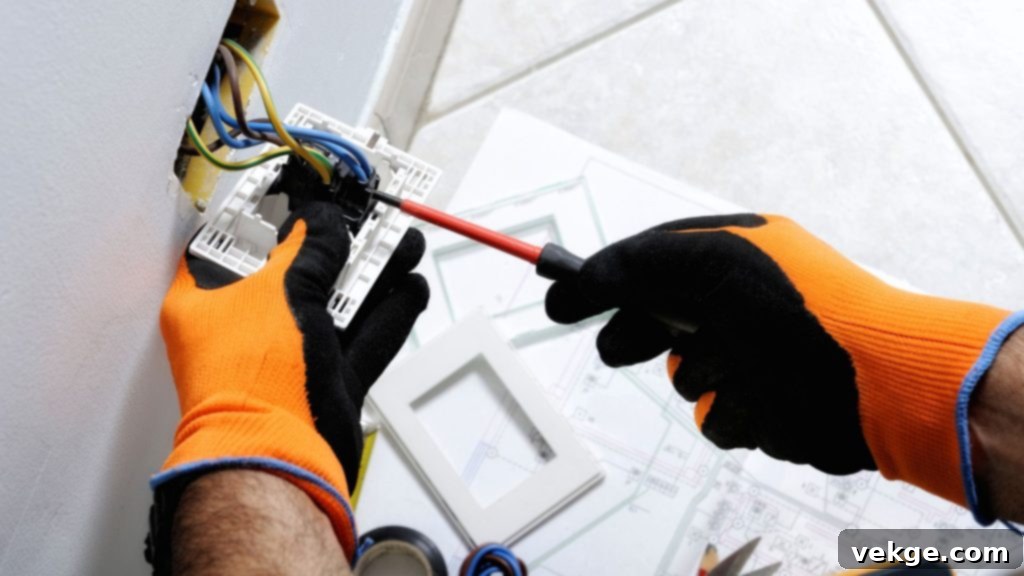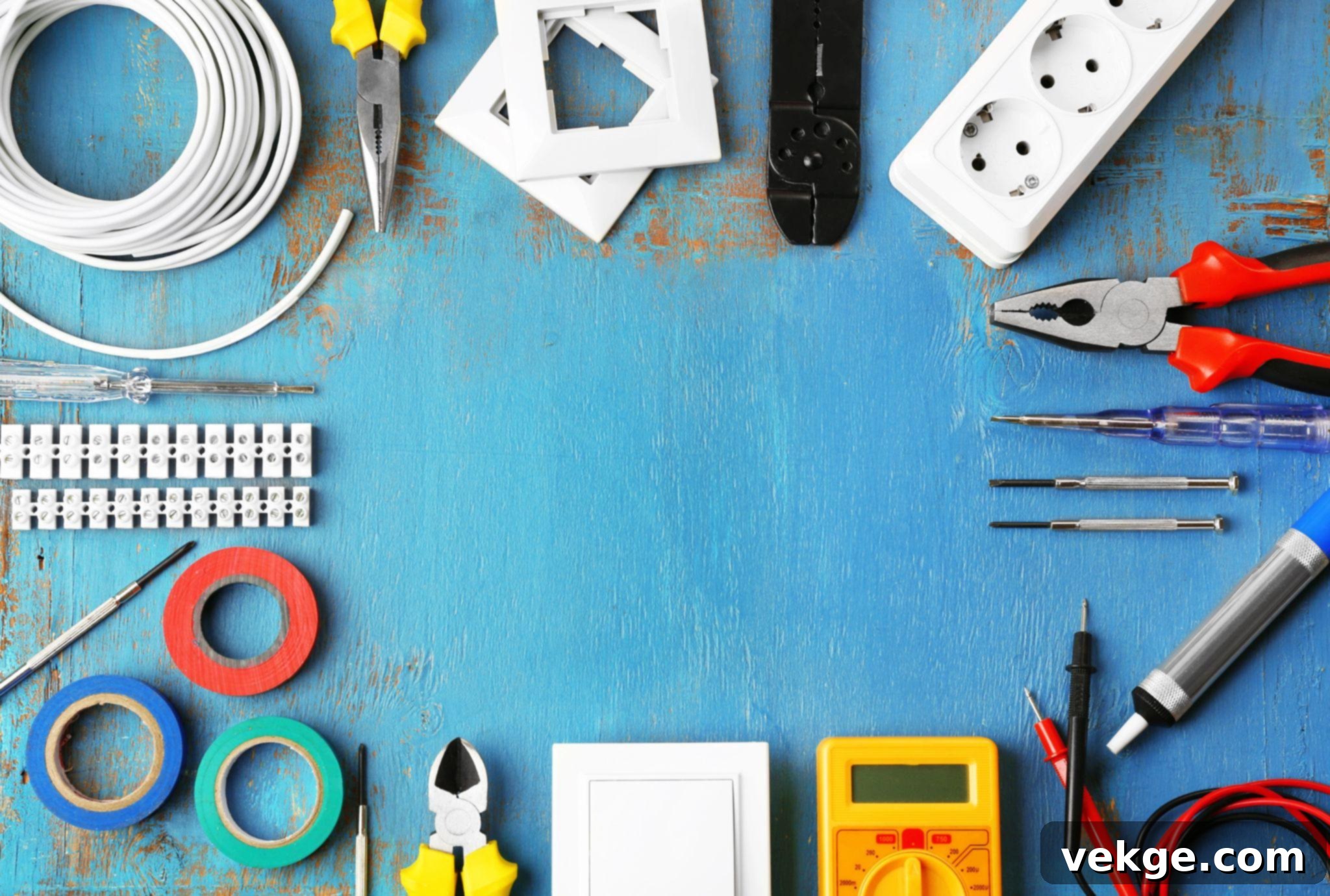The Ultimate Homeowner’s Guide to Choosing and Installing Safe & Efficient Electrical Supplies
When it comes to creating a safe, functional, and efficient home environment, the importance of selecting the right electrical supplies cannot be overstated. Homeowners are often faced with a bewildering array of choices, from basic wiring and outlets to advanced smart home devices, which can lead to confusion and potentially costly mistakes. This comprehensive guide aims to demystify the process, offering detailed insights and practical advice to help you make informed decisions about the most suitable and reliable electrical supplies for your unique needs. Furthermore, we will emphasize the critical importance of adhering to local electrical codes and regulations, ensuring not only the safety of your household but also compliance with legal requirements for all your home electrical projects.
Understanding Your Home’s Electrical Needs

The foundation of any successful electrical project begins with a clear understanding of your home’s specific electrical requirements. Every home has fundamental needs that form the core of its electrical system: reliable basic lighting, a sufficient number of standard power outlets for everyday appliances, and essential security systems to protect your property. However, modern living often extends beyond these basics. You might need to factor in additional components such as sophisticated alarm systems, cutting-edge smart home technologies that integrate lighting, climate, and security, or high-performance entertainment systems that demand significant power.
Your lifestyle plays a crucial role here. Do you work from home and require a dedicated office setup with multiple monitors and charging stations? Are you a passionate cook who relies on various kitchen gadgets? Do you have specific medical equipment that needs a consistent power supply? Each of these scenarios impacts the type and quantity of electrical supplies you’ll need. Furthermore, energy efficiency is an increasingly vital consideration. Adopting energy-saving electrical supplies, such as LED lighting, smart thermostats, and energy-efficient appliances, can lead to substantial long-term cost savings on your utility bills and reduce your environmental footprint. Look for products with Energy Star ratings or other efficiency certifications.
Future-proofing your home’s electrical system is another critical aspect. Consider potential home expansions, renovations, or lifestyle changes down the line. For instance, if you plan to add an extension, convert your basement, or set up a dedicated workshop, your electrical infrastructure will need to support these additions. The growing trend towards electric vehicles (EVs) also means many homeowners are installing dedicated EV charging stations, which require specific high-power circuits. Planning for these long-term goals now can help you avoid major, costly electrical adjustments and expenses in the future, ensuring your home remains adaptable and functional for years to come.
Essential Electrical Supplies Every Homeowner Should Know
A well-equipped and safe home relies on a robust selection of essential electrical supplies. Understanding these components is key to maintaining your home’s electrical integrity. At the forefront are **circuit breakers**, which are pivotal in safeguarding your home’s electrical circuits from overloads and short circuits. These vital safety devices automatically cut off power when an issue is detected, preventing potential fire hazards and protecting your valuable appliances from damage. Modern homes often utilize various types, including standard breakers, Arc Fault Circuit Interrupters (AFCIs) for bedroom circuits to prevent electrical fires, and Ground Fault Circuit Interrupters (GFCIs) for wet locations.
Beyond protection, **power outlets and switches** are the necessary access points that distribute electricity throughout your house. Outlets come in various forms, from standard 15-amp and 20-amp receptacles to specialized 240-volt outlets for high-demand appliances. Switches control your lighting and other fixtures, with options ranging from basic toggle switches to dimmer switches, smart switches, and motion-sensor switches for added convenience and energy savings. When selecting these, prioritize safety features and compliance with relevant electrical regulations. For instance, **Ground Fault Circuit Interrupters (GFCIs)** are absolutely essential for damp or wet areas such as bathrooms, kitchens, laundry rooms, garages, and outdoor spaces. These devices rapidly detect imbalances in electrical current and quickly shut off power, effectively preventing the risk of severe electrical shocks, which can be life-saving.
For minor repairs and quick fixes, maintaining a basic **electrical toolkit** is highly recommended. This should include spare fuses of various ratings, a wide variety of light bulbs (LEDs are now the standard for efficiency), high-quality electrical tape for insulation, and an assortment of wiring (e.g., 14-gauge and 12-gauge Romex for typical household circuits). A non-contact voltage tester is also an invaluable safety tool for verifying that power is off before starting any work. Consider adding a multimeter for more advanced troubleshooting. Remember, while a basic toolkit is useful for small tasks, any significant electrical work should always be handled by a qualified professional.
Safety Standards and Regulations
When it comes to handling and installing electrical supplies, safety is, without question, the paramount concern. There is nothing that trumps the importance of rigorous adherence to established safety standards and regulations. Compliance with local, national, and even international electrical codes and standards is not merely optional; it is a mandatory requirement designed to protect lives and property. Choosing electrical supplies that are compliant and certified by recognized bodies ensures that any installations carried out in your home are inherently safe, reliable, and meet the stringent criteria set by industry experts.

You can readily confirm that your chosen supplies meet the required safety standards by diligently checking for certification marks or labels from recognized accrediting bodies. In North America, look for certifications from organizations like Underwriters Laboratories (UL), CSA Group (CSA), and ETL (Intertek). These marks signify that the product has undergone rigorous testing and meets specific safety and performance criteria. Ignoring these certifications can lead to the purchase of substandard or counterfeit products, which pose significant fire and shock risks.
Furthermore, the most reliable way to ensure unwavering compliance with safety measures and regulations is to utilize the services of a professional, licensed electrician. These experts possess in-depth knowledge of current electrical codes, local ordinances, and best practices. They can not only guide you in selecting the most appropriate and compliant electrical supplies specific to your home’s unique needs but also ensure that all installations are performed correctly and safely, thereby mitigating risks and preventing future complications. An electrician can also provide crucial advice on necessary upgrades to bring older systems up to code, perform inspections, and issue permits, all of which are essential for maintaining a safe and insurable home.
Factors to Consider When Buying Electrical Supplies
When you’re in the market for electrical supplies, several crucial factors should guide your purchasing decisions to ensure you invest in products that are both safe and effective. **Quality and brand reputation** should always be at the forefront of your considerations. Reputable brands typically have a proven track record of producing reliable, durable products that undergo stringent quality control checks. Investing in well-known brands, even if they come with a slightly higher price tag, often translates to superior performance, greater longevity, and enhanced safety, ultimately saving you money and headaches in the long run by reducing the need for premature replacements or repairs.
Carefully weigh the pros and cons of **shopping online versus purchasing from a physical store**. Online platforms can be enticing with their competitive prices, vast selections, and the convenience of home delivery. However, it’s crucial to verify the authenticity and certifications of products when buying online, as counterfeit items can be a serious risk. Local physical stores, on the other hand, offer the invaluable advantage of expert advice from knowledgeable staff and the opportunity for hands-on assessment of products before you buy. You can physically inspect the quality, gauge the feel of materials, and get immediate answers to your questions. If you’re unsure where to buy electrical components, start by researching trusted local or online suppliers that are known for offering certified products, positive customer reviews, and excellent customer support to ensure you make the best purchase for your home.
Always weigh a product’s initial **price against its expected longevity and performance**. A seemingly higher upfront cost for a quality product can often lead to significant savings over time due to reduced energy consumption, fewer maintenance issues, and a longer lifespan. Conversely, opting for cheaper, lower-quality alternatives might lead to frequent malfunctions, higher energy bills, and the need for costly replacements much sooner. Additionally, thoroughly consider the **warranties and customer service offerings**. A robust warranty provides peace of mind and assurance of the product’s quality and expected lifespan. Excellent customer service can be a lifesaver in situations where products don’t perform as expected, or if you encounter installation difficulties, ensuring you receive timely and effective support.
Top Tips for Installing Electrical Supplies Safely
For the safe and compliant installation of electrical supplies, nothing surpasses the expertise of a **licensed electrician**. These professionals possess the necessary training, certifications, and experience to ensure that all installations adhere strictly to local electrical codes, national standards, and manufacturer guidelines. Hiring a professional guarantees that the work is not only correctly executed but also safe, reliable, and documented for insurance and resale purposes. They can also secure necessary permits and perform crucial inspections.
However, if you are a confident DIY enthusiast tackling minor electrical tasks, it is absolutely imperative to follow a stringent set of **basic installation safety tips**. Your safety is paramount. Always, without exception, ensure that the electricity at the circuit breaker or main disconnect is turned off and locked out before commencing any work. Use a non-contact voltage tester to verify that circuits are completely de-energized. Always use insulation-handled tools designed specifically for electrical work, wear appropriate personal protective equipment (PPE) such as safety glasses and electrical gloves, and work in a dry environment. Never work on live circuits. If you feel uncertain at any point, stop immediately and call a professional.
Developing an understanding of how to handle common electrical installation challenges can help you avoid complications. This includes selecting the correct gauge of quality wiring for specific circuits, properly securing outlets and switches within their boxes to prevent loose connections, and safely handling circuit breakers and fuses. Familiarize yourself with basic wiring diagrams and always consult product manuals for specific installation instructions. Beyond initial installation, **regular maintenance and inspections** are critical to ensuring your electrical setup remains safe and efficient. Periodically inspect visible wiring for signs of wear, fraying, or damage. Check outlets and switches for loose connections or signs of overheating (discoloration, warmth). Be vigilant for overloaded circuits, which can manifest as frequently tripping breakers or flickering lights. Addressing these issues promptly can prevent serious hazards like electrical fires or system failures. Knowing where your main breaker is located and how to shut off all power in an emergency is also a crucial aspect of home safety preparedness.
Conclusion
In summary, the critical importance of carefully selecting and properly installing the right electrical supplies for your home simply cannot be overstated. By prioritizing quality, safety, and compliance with regulations over mere cost, homeowners can effectively prevent future complications, mitigate significant risks, and ensure a safe, efficient, and reliable dwelling for all residents. Being well-informed about your home’s electrical needs, understanding essential components, and actively seeking professional advice when necessary are key strategies to avoid costly mistakes and long-term issues that could compromise your family’s safety and comfort.
We strongly urge all homeowners to regularly evaluate their current electrical supplies and infrastructure, developing a clear understanding of their home’s evolving electrical needs. Consider necessary upgrades, especially with the advent of smart home technologies and energy-efficient solutions, to enhance both functionality and safety. By doing so, you not only improve your home’s operational capabilities and protect your investment but also ensure unwavering compliance with all necessary safety standards and regulations. This proactive approach guarantees a secure, efficient, and modern living environment, offering peace of mind and a higher quality of life for everyone under your roof.
